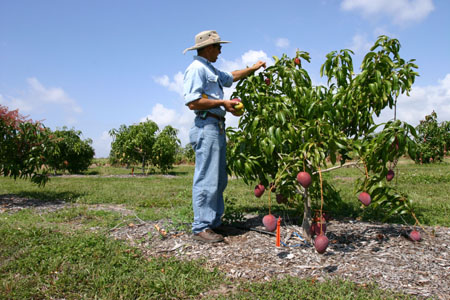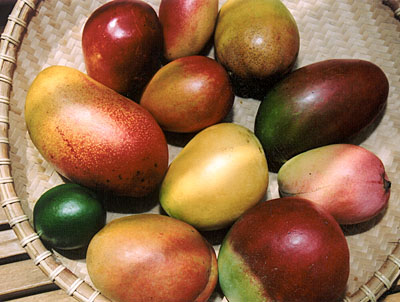

Photo credits to Robert Parente
Condo Mangos: Mangos in the Lanai!
Doug Caldwell, University of Florida, Collier County ExtensionThis is a relatively new concept and
there may be some drawbacks, but the results will be worth the experimentation.
Things to remember, mangos are frost sensitive. Temperatures of 26
to 28 degrees F may kill younger trees. Mangos are related to poison
ivy. If you have never tested this, go slowly with handling plant parts,
the resin from stems, fruit (especially the skin of green mangos) have
caused blistering on sensitive people. In extreme (rare?) cases, volatiles
from the flowers may cause allergic reactions such as eyelid and facial
swelling and respiratory difficulties if prolonged exposure occurs.
Simply washing after handling plant parts will avoid problems for
most people. Don't pig-out on peck of mangos, if it is your first tasting
experience. Also, where will you be when the mangos need picking? This
isn't a fruit tree for the typical snowbird. If you aren't in town
from May through late August, you will miss the major harvest period.
Now, on to the honey, peachy flavored rewards. Some of the 'Curator's
Choice' cultivars to consider are 'Duncan', 'Neelum', 'Manilita',
'Ice Cream', 'Lancetilla', 'Cogshall', 'Fairchild', 'Graham' and 'Mallika'.
Fairchild's website information, which reads like a wine connoisseur's
evaluation with a mango twist, includes details on fruit size, nuances
of flavor, color and harvest times. 'Ice Cream' is green when it is
ripe, but 'Cogshall' has an "eye-catching yellowish-orange skin, overlaid
with a brilliant crimson blush". Fruit weight can range from a few
bites with the eight-ounce 'Ice Cream' mango or to a few meals, with
the two to five pounders from "Lancetilla'. 'Rosigold', which Fairchild's
Mango Curator, Dr. Richard Campbell, describes as "rich, aromatic,
and sweet, with a hint of the Asian Tropics" ripens in mid to late March.
The "exceptionally high quality South Indian dessert mango", 'Neelum'
ripens in October.
Pest problems don't require constant vigilance, but include: mites,
scales, thrips and powdery mildew, which can destroy flower panicles
and cause a crop failure. See, more on pests and how to grow mangos
at: http://edis.ifas.ufl.edu/MG216.
| Lovebugs help pollinate mango flowers as they go about their normal business. |
Pollination is primarily by flies, ants, wasps and moths. Honeybees
aren't especially attracted to these flowers. I noticed a lot of lovebugs
frequenting my trees' panicles. I knew that they had to be beneficial
in some way other than as hood ornaments. There is some self-pollination,
but you may need to open the door for a few hours to let the pollinators
into your screened lanai. My wife stands loyal to peaches and tends
to turn her nose up at mangos, but I'm a mango guy now. They are just
so refreshing and try fresh mango ice cream, wow!
For more information on home gardening, contact the University
of Florida, Collier County Extension Service, Master Gardener Plant
Clinic, at 353-2872. If you have a specimen that you want identified,
the Plant Clinic, at 14700 Immokalee Rd., is open Monday, Wednesday
and Friday, 9 a.m. to noon and 1 p.m. to 4 p.m.
E-mail: dlcaldwell@ifas.ufl.edu; call 353-4244.